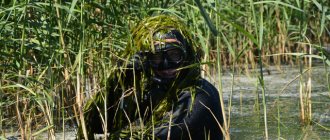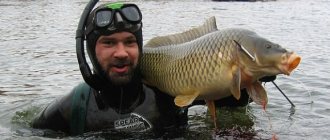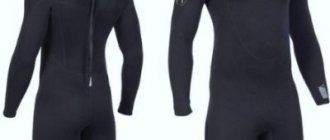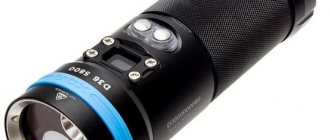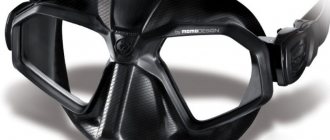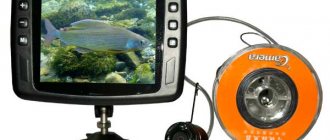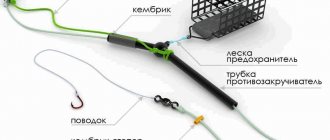What's good about spearfishing?
The smooth, mirror-like surface of the Dnieper is only occasionally disturbed by diverging circles in the water from frolicking fish. At some point, something round with horns appears from the depths. Like a floating mine. The object is moving towards the shore. The figure of a smiling young man in a “horned” mask and glasses reminiscent of a porthole gradually emerges. He swims towards the shore, making sweeping movements with his arms.
A diver comes to land. He is wearing swimming trunks and thick rubber flippers that resemble frog legs. On his hands are webbed gloves - they contain an almost meter-long aluminum tube, which at first glance you involuntarily mistake for a pistol. After a short time, the person will disappear under water again. And after 10-15 minutes he will swim out again, this time with prey in his hands.
This is what the first divers of the USSR looked like. This is how Komsomolskaya Pravda described them in 1955.
HOW AND WHERE TO SEARCH FOR FISH ON SPEARFISHING: METHODS OF SPEARFISHING
What an underwater hunter should be able to do:
- swim and dive silently;
- hold your breath for a long time;
- know the habits and biology of fish;
- know the specifics of reservoirs and choose the right hunting method;
- be able to shoot quickly and accurately.
An underwater hunter always swims slowly and does not make sudden movements so as not to scare away the fish. A novice hunter can be identified by the fins hitting the water and the raking movements of his free hand.
Some of us, in order for the fins to operate silently, wear strap bracelets with weights on our legs. The hand free from the gun is usually relaxed along the body; sometimes the hunter holds onto underwater logs, stumps or stones with it.
If the depth is less than 4-5 meters, a gradual and quiet immersion is used: the hunter folds in half, immerses his head and torso, then, straightening up, takes his “fifth point” under the water and not vertically, but gently goes to the depth. It turns out slowly and silently.
There are three main methods of underwater hunting: search, laying and rafting. In different bodies of water, in different parts of it, at different times of the day and for different fish, one or another method can be used.
The emergence of interest in a young sport
In the second half of the 20th century, underwater fishing began to develop abroad, which in essence is more reminiscent of hunting. The main distribution areas are the coasts of California and the Mediterranean Sea. The first clubs for underwater hunters opened in Italy, France, North America, and Australia. On the basis of these organizations, thematic literature is published, competitions and competitions are held.

As of 1955, there were nearly 50 thousand spearfishing enthusiasts in England. And at the beginning of 1956, interest in the depths reached the USSR, when the color documentary “20 minutes under water” produced in France was shown in cinemas. Viewers had the opportunity to take a fascinating journey into the depths. Most of the footage told about rocks, algae of unprecedented shapes and colors, evidence of ancient shipwrecks that keep their secrets. But the main thing that the film told about is that this unprecedented world is accessible to almost everyone.
Mexico
There are many places for spearfishing in this Latin American country. The main trophies will be yellowfin tuna and marlin. Hunting is carried out from boats, at depths from 3-5 to 20-25 meters. In Mexican waters, underwater visibility is excellent. But it is prohibited to use scuba gear, hunt in national parks, or at dive sites. Night spearfishing is also prohibited.

The meaning of the sport
Despite the fact that this activity is predominantly amateur, it is of great importance for science. Experience has shown that ichthyologists often collaborate with underwater hunters to exchange information. This allows for more careful observations and study of the underwater world from a practical point of view. Our country is rich in natural resources, so such research assistance is very important.
The first underwater fishermen worked on the Dnieper. Previously, this sport was mainly of interest to young people, but now older people are also paying attention to it.

Spearfishing is important for strengthening the body and spirit. The athlete has to sit in ambush, conduct reconnaissance, look for prey, and make accurate shots. And sometimes engage in battle with aquatic predators. Certain skills required:
- swimming;
- diving;
- ability to control breathing;
- shooting.
Every skill develops with practice, but a hunter must have a “base” to begin with. Subsequently, dexterity, observation, determination, and speed of reaction are cultivated in him.
The equipment with which the fisherman goes to the depths is also important.
Equipment and equipment
Having discovered potential prey, the hunter hits it with a special gun. The weapon shoots harpoons that dig into the body of the fish. The tackle is attached to the line, which, in turn, is wound onto the reel. In this way, the fish can be attracted to you.
The required set of equipment is simple. This is a mask with a respirator (previously self-contained helmets were used), a special suit, a compressed air cylinder, fin fins, a gun, a supply of harpoons and bowstrings. Foreign hunters take with them some auxiliary devices:
- belts with pockets and carabiners;
- shotgun loaders;
- special daggers, knives, kukans;
- watches and compasses in waterproof cases;
- echo sounder;
- depth gauge..
For safety, special suits, vests are required (they make it possible to instantly discard equipment in a critical situation), rescue shoulder pads, which are filled with carbon dioxide from ampoules in the event of an accident, and more.
Let's take a closer look at individual types of equipment.

Weapon
Underwater crossbows with a bowstring made of elastic materials and guns powered by spring power, which are widespread today, came to us from abroad. Guns with a sealed barrel are popular among American hunters. It uses cartridges charged with gas or explosive under high pressure. Hydraulic and rocket guns are also common.
The standard length of the weapon ranges from 140 to 160 cm, but short samples (110-115 cm) are also produced. Such small models, as well as special pistols, are used for hunting in difficult conditions, when the shooter has to work between rocks, in grottoes, and crevices.
For long-distance shooting, as well as in cases where the target is a long fish, guns up to 2 m with a spring are effective. Typically, the design of such models involves a super-compressor.
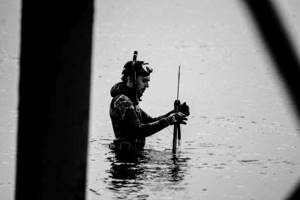
Some anglers prefer to hunt at night. They choose illuminated guns or use special flashlights.
Crossbows are designed in this way: a lightweight hook (or shoulder rest) is located in the tail, and the release mechanism and pistol-style handle are in the middle. To ensure that the gun lies more securely in the hunter’s grip, there are supporting handcuffs. It is important that the weapon is not bulky. This makes diving difficult. Sometimes air-filled pipes are installed on crossbows.
The killing distance depends on the type of gun. It ranges from one and a half to two to 6-7 m.
Mask
The mask protects the diver's eyes and allows him to see underwater without obstacles. Some models are designed in such a way that they can also provide breathing. Previously, they had a binocular shape. However, this has a detrimental effect on vision. Abroad they began to produce products equipped with a solid, most often round, viewing glass.

Masks with respirators are classified depending on their design:
- products in which breathing is carried out through the nose (the mouth is free);
- products where the respirator covers the mouth and nose.
The mask is equipped with one (less often two) breathing tube. It is located above the diver's head, on the surface. If two tubes are used, they are positioned on either side of the swimmer's head.
A strap is used to secure the mask. The old tubes were designed in such a way that when diving to a depth, when they sank below the surface, water filled the cavity. Today's equipment does not have this defect. A valve is installed in the tubes to block access to the respirator.
Spacesuit helmets make movements more free than when using a mask, but are prohibited in many countries due to unsafety.
Types of spearfishing
Depending on the goals, there are several types of spearfishing.
- Traditional human activity, which has historical roots and is aimed at the extraction, reproduction and protection of water resources. This activity is carried out without technical means and solely due to the capabilities of the human body. It's called underwater fishing.
- Spearfishing, as a part of fishing, the purpose of which is small-scale production of fish. Fishing methods are used by hand or harpoons. It involves detecting and pursuing prey while the hunter moves freely in the aquatic environment.
- Sports spearfishing is carried out in order to improve a person’s physical skills and is not aimed at mass fishing.
- Spearfishing using permitted types of fishing.
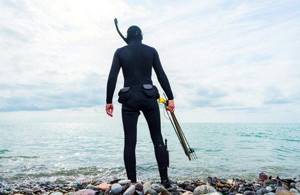
Flippers
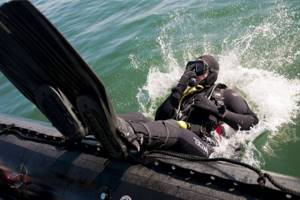
Fins allow you to cover long distances by increasing the force of your kick in the water. Movement speed also increases. This is important because the hunter does not have much time to spend at depth. Manufacturers produce two types of “fins”:
- with a shortened sole (the heel remains bare);
- with a sole for the entire length of the foot.
Some athletes prefer not to use fins. They explain this by saying that their legs get tired from their heaviness.
How to Prepare for a Hunt
To start classes you do not need to have any special physical characteristics. This is available to all people with healthy lungs, heart, nervous system and good vision. Women can also hunt underwater. There are many athletes abroad who have chosen this particular discipline.
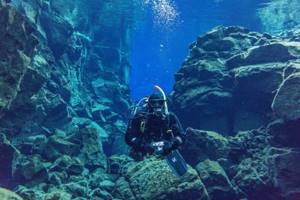
Those wishing to engage in spearfishing should familiarize themselves with the equipment and equipment. They learn to work with it. But the most important thing in hunting underwater is breathing. Many instructors begin their classes with it. The fisherman must develop a breathing rhythm with a respirator. The exercises are first carried out on land. Descent into the water is allowed only when the hunter learns to make breathing movements automatically, without concentrating on them. Otherwise, all his time at depth he will be fixated on its correctness, and not on anything else.
Training begins with learning to work with a mask on land. When the future underwater hunter has thoroughly mastered everything necessary, they move on to exercises in the water. First, the diver stands with his feet on the bottom of the pool or pond and dives headfirst. Only after this do they start swimming. The most important part of diving is diving. There are several descent methods:
- vertical;
- sloping (diagonally);
- to a shallow depth in a standing position.
The first option is necessary when the potential prey is directly under the hunter. It is advisable to be familiar with all the techniques. They are useful in reconnaissance, tracking and hitting targets.
Spearfishing for Beginners
This galaxy of future “underwater wolves” needs to pay special attention to the advice of older, experienced comrades and remember about safety. Even after making several collective dives and obtaining a trophy, it is unacceptable to hunt for fish without the insurance of a second expedition member for the “tails.”
We need a partner who can come to the rescue at any moment. Therefore, there must be set No. 1 on the shore, which we will talk about a little later.
When separated from the shore by more than 100 meters, the second member of the team insures the diver, being in close proximity to him in the boat.
Spearfishing for beginners means strictly following the rules of behavior under water and consolidating theoretical material. Secondly, the hunt itself.
For a group dive, a comfortable distance is 10-15 meters. A young underwater hunter needs to remember that it is impossible to shoot at random without seeing a clear target. You could mistake your friend's flippers for a passing fish.
Fortunately, there are no predators in the rivers and lakes of the post-Soviet space: stingrays and sharks. This makes me happy. There is another problem: abandoned nets with rotting fish, fittings and other dangerous debris. These items are no less insidious and dangerous than the “friendly shark smile”.
Spearfishing for beginners means following the rules of behavior with weapons. It is armed and discharged in the water. Hunting is not allowed in crowded areas.
Experiences of famous athletes
Dukan, Rogi and Diole are well-known foreign submariners. They recommend starting each dive with a survey of the reservoir, the purpose of which is to determine the main characteristics - coastal profile, bottom topography, depth, vegetation, presence of shoals, etc. If this is not the first time you are diving in the chosen place, the examination can be carried out more quickly or, in extreme cases, omitted altogether.
Shallow bodies of water can be explored without being completely immersed. At greater depths or low transparency, when the bottom is not visible, the hunter needs to dive to fully view it.
An inspected body of water will not only make diving safer, but will also help determine the types of fish present in it and tell you where to look for them. For example, a lot of prey is hidden in algae thickets, in rock crevices or between boulders. Some species, such as the stingray, on the contrary, lie shallow, slightly buried in the sand. To distinguish it, you have to look at the bottom for a long time. The silhouette and small black eyes give away potential prey. There's no time to waste. The hunter should, without going down to the bottom, shoot at the center of the stingray's body.
It is important to remember that each technique is effective when hunting certain species. It is necessary to study information about all the fish that live in the reservoir chosen for fishing.
The hunter's tactics are developed in accordance with the habits of the species of aquatic inhabitants. For example, according to experts from abroad, the head, lateral line organs, and the base of the tail fin are the most vulnerable places on the fish’s body. In this case, the damage from a hit in these areas will be different. A head wound is most often fatal. A hit in the spine (back) will completely or partially immobilize the prey, weaken it and not give it the opportunity to resist or attack. But it is most advisable to inflict such a blow on crabs, flat fish - flounder, stingray, etc.
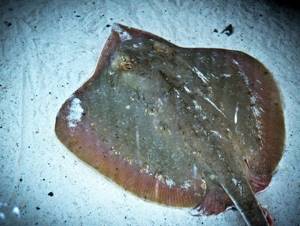
Damage to the lateral line will disrupt the fish's coordination. This is the most profitable option.
It is inconvenient to hit the fish from the front. From this angle, the “target” is small and difficult to hit.
It is rare to shoot prey in the stomach. This is only possible if the fish swims above the hunter.
You also need to take into account the firing angle. This is important, for example, when hunting carp or lobia, which have strong, large scales from which an arrow can bounce off. An angle of 45° should be maintained.
At a moving target, just like on land, they shoot ahead. In water, a hunter has more room to maneuver than on land. The fisherman, after he hits the fish, pulls up the harpoon line using a reel or hands. They do this quickly so that the escaped prey does not break or tangle the thread.
To release the spear or harpoon from the body of the fish, use a knife, making cuts in the place where the teeth of the tackle are attached. Some models are available with detachable slits. There are special “scissor arrows”. They are easier to remove from affected fish.
J. Dukan shares his experience of catching the sultana in the Mediterranean Sea, where large specimens reach 50-70 cm:
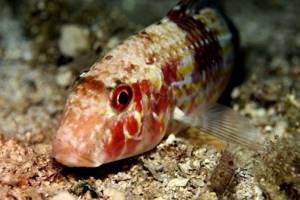
“I have found sultana at different depths. Most often it hides in algae thickets or lies on a rocky bottom. In general, you can look for it at a depth of 1.8-4.5 m. The Sultan needs to be “tamed.” She is very shy, but if you approach her slowly, it is not very difficult to catch prey. First you should just let her get used to someone else's presence, and then carefully approach closer. Sultanas are one of those fish that love to swarm in the sand. You can shoot if you catch her doing this - at this time she is serene and will not run away when she senses the approach of a hunter. The distance needs to be as short as possible.”
Useful tips and safety rules
What else does a hunter need to know before heading to the pond? First of all, you need to prepare for scuba diving and make sure that the skills of the swimmer and diver are at the proper level. When hunting in water, the following rules should be observed:
- Carefully monitor the time during which the fisherman remains in the water column. You cannot remain at depth until the last moment, when it is already difficult without air, otherwise you may lose consciousness.
- If water vehicles may appear on the surface, care must be taken not to surface close to them and not hit or collide with the blades.
- You can only unload a gun during spearfishing in water.
- If you wound a large fish, you should not swim to it right away.
- Spearfishing in overgrown waters with many obstacles is dangerous; it is better to avoid such places.
- The dive must be done only while inhaling.
- When hunting, you should be guided by your level of experience and training and not perform complex dives and other actions for which you lack knowledge and skills.
Spearfishing can be a fun and exciting activity once the fisherman masters the basic rules and techniques. Then he can benefit from numerous tips from equally enthusiastic hunters, which will help increase the catch and efficiency of hunting. The most famous of them:
- The most favorable time for spearfishing is morning.
- It is more convenient to dive with your legs bent at the knees and your head down. Then, in the water, the legs straighten sharply.
- When hunting, they approach fish by taking a horizontal position in the water.
- When hunting, it is better to aim at the head and sides of the fish.
- It is better to approach the fish by being slightly above or below it. The closest she gets to her is when she eats.
- When hunting underwater, you need to move as silently as possible so as not to scare away the fish.
In case of injury, loss of consciousness or other emergency situations, you must immediately seek medical help. Therefore, you should not hunt alone; it also does not hurt to learn the rules of first aid. Knowing the basic rules of spearfishing is necessary in order to have a good time and not be in danger. Having mastered everything that a beginner needs, the fisherman will soon begin to enjoy the process greatly, because this is a truly exciting and exciting pastime. It is no coincidence that entire championships and competitions are organized in this sport.
The dangers of spearfishing
Discipline itself is not dangerous. This shows the experience of athletes who have been actively engaged in underwater fishing for 5-10 years. Hunting requires strict adherence to established rules. If all requirements are met, the risk of an emergency situation posing a danger to life is minimal.
Factors that can lead to accidents:
- non-compliance with the physiological regime (violation of breathing rules); lack of awareness of representatives of aquatic fauna and the danger they may pose;
- unsuccessful choice of a place for hunting, unscrupulous inspection of it;
- carelessness in handling weapons.

Spearfishing spot
Each region is assigned some areas equipped for spearfishing; you can ask about them at the sports fishermen’s club. If you are not satisfied with the proposed places, then you can try to find another one. For ease of underwater fishing, it should be a large body of water or a wide river. Equally important is underwater visibility. The important word here is underwater. Very often sand floats on the surface, but at a depth of 20 cm there is excellent visibility and vice versa. Underwater vegetation and texture are not particularly important, but it is certainly easier to study in a visible area rather than in algae thickets, although they also have advantages, for example, they can be used as an excellent shelter. Also, do not forget about the safety of others, which is why it is recommended to coordinate all spearfishing in unprepared territory.
Let's look at potential dangerous situations using examples.
Beginners, ill-informed or simply careless hunters may exaggerate their capabilities. Unable to regulate their breathing, they get carried away and swim to great depths, or spend more time under water than they should. This is fraught with such dangerous health consequences as pulmonary emphysema, nose or ear bleeding, arrhythmia, convulsive contractions of the muscles of the limbs, loss of consciousness, during which oxygen does not reach the brain.
Hunters who are not familiar with the species inhabiting the chosen body of water are faced with injuries caused by certain fish or other underwater animals.
The danger is:
- stingray (sea cat) – leaves long-lasting, painful lesions;
- stinging jellyfish - the pain is similar to a burn or electric shock, allergic reactions are possible, including anaphylactic shock;
- sea ruffe (Black Sea scorpionfish) - damage by the thorn is painful, allergies and inflammation may occur;
- sea dragon - the venom of the thorns causes severe pain and is fatal in high concentrations.
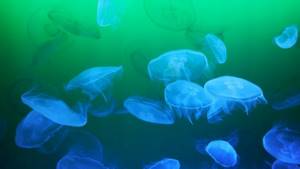
If the place is chosen incorrectly or the reservoir is not studied enough, there is a risk of falling into a cave or crevice, or getting stuck in a narrow passage between stones. Nets and various traps also pose a danger, so you should beware of places where fishing is active or where hydraulic structures are located.
It is important to handle weapons competently and carefully. On land, underwater crossbows shoot further (20-30 m or more). You must not point the gun at yourself or other people.
Sharks and octopuses pose a great danger, but they are practically never found in the waters of our country. Most stories about these species of sea inhabitants are exaggerated. Cephalopods are found in the Sea of Japan, but do not pose a danger to underwater fishermen. The octopus is a cautious, timid animal. He avoids contact with people in every possible way. At the same time, he can become prey. The mollusk should be hit in the head. This can be done not only with a harpoon, but also with a dagger.
Sharks that can be found in the waters of our country do not pose a danger to the hunter. They are found in the Black Sea and the Far East. Katranas are small in size, but have spine-like processes on their fins. This can cause injury if you are not careful. Herring sharks are larger, but also not dangerous for an experienced, careful fisherman.
Underwater hunter and photographer Hans Has spoke about his encounters with sharks. Gilbert Dukan had the opportunity to come into contact with this fish in the Mediterranean Sea. All cases ended successfully. The hunters did not show excessive interest in the sharks, and they also did not pay attention to people.
Abroad, where this dangerous fish is common, they use a special device. The device is assembled from two folding electrodes and a battery. The device creates an electric field around the diver. Waves scare away sharks. The device is small in size and fits into a belt bag.
Implementation procedure
According to the norms and rules established by the legislation of the Russian Federation, the right of capable citizens of the country to underwater fishing as a form of hunting and recreation is inalienable. To be able to engage in this type of activity in the zone of economic interests of Russia, you must have the appropriate certificate. Such a document is issued by departments authorized by the Russian Federation. In addition, a certificate can be obtained from clubs, various organizations, and legal entities licensed to train underwater hunters and fishermen.
Those citizens who actively participate in specialized competitions and trainings with a clearly established amount of permitted catch must have the above-mentioned document with a special mark - “athlete”. It is certified by the regional animal protection inspectorate or approved by the seal of Glavrybvod.
Qualified athletes are those who have a non-zero level of the appropriate level. Specialization can be all-Russian or territorial. The Athlete qualification is awarded for the current year. The basis is the RFPS classification.
The leadership of the Russian Federation of Underwater Sports (president, chairman of the board, executive secretary) submits information to Glavrybvod every year. Among other information, there are lists of people with appropriate qualifications included in the national ranking. This information is also transmitted to the fisheries inspection.
To receive an individual rating, an athlete must earn qualifying points in competition. Only competitions included in the all-Russian calendar of the Underwater Fishing Federation are taken into account. For a territorial sports rating, you need to take part in competitions on the national calendar. They can be organized by RFPR branches at the regional level.
Professional spearfishing involves training and competition. They are carried out according to special rules. Amateur activities in this area are carried out in accordance with this provision.
Conditions for spearfishing in the territory of the former USSR
Suitable for underwater hunting are sea coasts and inland waters. Valuable species of fish are found in their depths. But spearfishing is not always and not possible everywhere. It largely depends on weather conditions, as well as other factors. Water transparency is also important, determining visibility and temperature conditions, which fluctuate throughout the year.
Most often, bodies of water that are suitable for swimming in warm weather are also suitable for spearfishing. Safety is also an important criterion. According to medical standards, the temperature for swimming should be at least 18°C. In summer, most reservoirs in the middle zone and in the South warm up sufficiently.
The duration of the “warm” period depends on geographic latitude. In some places the hunting season coincides with the swimming season, in other places it lasts much less. For example, on the shores of the Black Sea, underwater fishing can be practiced from mid-May to early October, but in the Moscow region only 2-3 months in the summer. This depends on the heating characteristics of the reservoir. For divers, it is important that the temperature at the desired depth is acceptable. In lakes and artificial reservoirs, only the upper layer warms up; the difference with the lower layer can be several degrees. It is called the “temperature jump layer.” The higher it lies to the surface, the more difficult it is to spearfish. Therefore, the development of the discipline is moving slowly in inland waters. The Baltic Sea, since it is inland, also poses certain difficulties.
Transparency is another important criterion for assessing the suitability of a reservoir for spearfishing. The swimmer must see the bottom and the space around him as clearly as possible. Transparency depends on the content of foreign particles in the water. This indicator determines the area and depth of hunting areas.
During rains or storms, coastal runoff increases and transparency becomes lower. Due to strong currents, some rivers are also insufficient for underwater fishing. The transparency of phyto- and zooplankton, flowering or death of plants is affected.
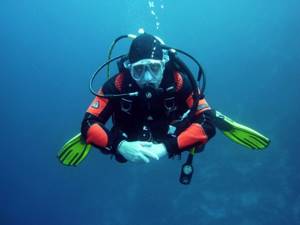
The indicator is determined by immersing a white disk (diameter up to 30 cm) to a depth. The limit of its visibility is the transparency value of a particular body of water. That is, if it is equal to 6, this means that a disk lowered below 6 m is not noticeable from the surface. The Mediterranean Sea is characterized by high transparency. In different areas it ranges from 20 to 60 meters. The extreme limit of the transparency indicator for some inland water bodies in the territory of the former USSR:
- Terletskoye Lake – 22 m;
- lake Turgoyak – 12 m;
- lake Pereyaslavskoe - 8.5 m;
- Valadaiskoe lake – 5.5 m;
- Seliger - 3.5.
Low visibility is observed in the lake near Moscow. White - up to 0.8 m. The transparency of the Black Sea waters reaches 20-30 m. The Aral Sea is characterized by 24 m. The Sea of Japan is also characterized by good visibility. It is suitable for underwater fishing, despite the fact that the indicator decreases towards the shore. The transparency of the Azov and Caspian seas is low. Despite this, they are quite comfortable for diving and hunting.
Kenya
Located on the east coast of Africa, washed by the Indian Ocean.
Who you can hunt:
- marlin, sailfish, cobia, tuna, king mackerel, wahoo, barracuda, sea bass.
Hunting season: all year, except June and July, when the sea is stormy; Peak season is from November to April.
Kenya is considered one of the best places for diving and spearfishing. There is almost no industrial fishing in these places. Therefore, marine inhabitants have the opportunity to reproduce and grow to gigantic sizes. From February to March, whale sharks often visit here. You can’t hunt them, but you can swim very close and see these amazing huge creatures with your own eyes.
The Kenyan tourism industry is developed: Europeans love to vacation here. There is something to see when spearfishing gets boring.
Optimal conditions for underwater fishing
The conditions of the Black Sea remain the most favorable - clear water, warm southern sun. Athletes will be interested in the rich fauna and flora - about 167 species of fish live in the depths.
The temperature allows hunting up to 5 months a year. The water warms up best in August. Average for different parts of the coast:
- Batumi – 24.4°C;
- Kerch Strait – 23.3°C;
- Crimean peninsula (southern coast) – from 22.2 to 23.2°C;
- Cape Tarkhankut (West of Crimea) – 22.8°C;
- Dnieper Estuary – 22.2°C;
- Odessa – 21.6°C.
Along the shore, among the rocks, stones and algae, a variety of fish are hidden. Such areas for the hunter become real places of “unafraid game.” Prey can be species with telling names - quail, hazel grouse or other representatives of the wrasse species.
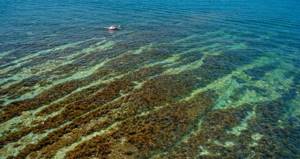
Underwater fishermen of the Black Sea region can expect frequent encounters with crucian carp, ruffe, mullet, garfish, and trigla. There are also large individuals that reach more impressive sizes:
- light (samples over 1 m and 32 kg were found) and dark croaker (50 cm, 3-4 kg);
- flounder-kalkan (up to 15 kg);
- sole;
- Katran shark (up to one and a half meters);
- beluga (up to 3-4 m);
- sturgeon (up to 2 m);
- spiny stingray (length up to 1 m) and stingray (up to 1.5 m), etc.
Flounders and rays preferentially bury themselves in the sand. The latter, as dangerous predators, ambush small species of bottom fish.
Off the coast you can see large schools of mackerel, bonito, horse mackerel, and less often tuna. The latter can sometimes reach up to 3 m and 600 kg. Catching tuna is a rare practice for underwater fishermen.
Sturgeon will become a valuable trophy:
- stellate sturgeon;
- thorn;
- beluga;
- sturgeon.
However, hunting these fish is not very encouraged. It would be better to ban this practice. Even during commercial fishing, population indicators are taken into account. In addition, the state is carrying out complex work on the artificial reproduction and population of reservoirs with these breeds. It would be reasonable to take this point into account when drawing up a set of rules and recommendations for spearfishing.
In addition to fish, the Black Sea will delight the diver with large breeds of crabs. He will have the opportunity to watch or even swim with dolphins. You can see the shell of a large mollusk – rapana.
Be aware of the possible danger. Most emergencies arise due to lack of awareness and knowledge of the rules of behavior when encountering dangerous species. For example, at the bottom you can see a sea dragon. This is a small fish (up to 30 cm) with poisonous spines on the gills and fins. A sea dragon buries itself in the sand. He may attack if disturbed.
The scorpionfish, known as the sea ruffe, is also poisonous. A dangerous substance is released by a solid ray located on the fin of the back.
Occasionally in summer, a single swordtail may enter the Black and Azov Seas. Cases have been witnessed of the fish damaging light boats and even more durable oak hulls covered with sheets of copper with its long bony appendage. The swordfish can move at a speed of close to 100 km/h, so it is extremely dangerous for humans.
Other "fishing spots"
Those who find themselves near Vladivostok are recommended to visit the shores of the Sea of Japan. These are picturesque places with rich fauna. Among the rocks and thickets hide starfish and urchins, sea cucumbers (sea cucumbers), swimming crabs, spiny crabs, as well as herring sharks, stingrays, octopuses and other unusual species. Suitable fish for hunting include Japanese ruffe, tuna, mackerel, yaok (goby), and flounder. There are armored species, for example, Agonmala.
Good conditions of the Azov, Aral and Caspian seas allow active underwater fishing for a long time. Among the valuable species, the following types are distinguished:
- bream;
- zander;
- carp;
- some sturgeon.
Azov is famous for mullet, gobies of various types, garfish, flounder, etc. Closer to the southern coast there are mackerel, bonito, and sometimes tuna. Sometimes you can admire dolphins.
The specifics of the Caspian Sea make it possible to meet pike and catfish in its desalinated areas. Due to the fact that there is enough space and resources for growth, giant specimens are encountered. At the depths of the Caspian Sea, fisherman will find such trophies as mullet, herring, and gobies. Perhaps you will be able to admire the seals.
The clear waters of the Aral Sea are very convenient for practice. The hunter will learn to scout and observe potential prey.
Prospects
The catch of a fisherman operating underwater is often larger. Even when there is a “calm” in the reservoir and there is no bite, in the depths of lakes, seas, rivers or ponds you can always find pike, ide, bream, perch or tench. In addition, such experience is useful and interesting.
Some people believe that this sport is expensive. This is wrong. Among foreign professionals and amateurs there are many ordinary workers, students or artists.
If government organizations take over the spread of the sport. The Komsomol undoubtedly plays a big role in this. The development and production of basic equipment and auxiliary equipment (waterproof cameras, depth meters) is actively underway. Particular attention is paid to safety. Life jackets and shoulder pads are produced that are inflated with carbon dioxide during emergencies. The procedure for athletes to undergo medical examinations is being discussed. It would be advisable to introduce a special periodically renewed ticket giving the right to spearfishing.
Spearfishing: what equipment to use
Let's look at the points:
- The first point is that the hunter needs a spearfishing license, which is issued only upon joining the sport fishing club. Without it, you will not be able to buy a hunting weapon, and even if you can, your actions will be illegal and will be regarded as poaching.
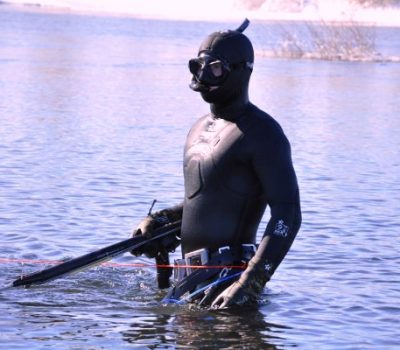
Gun or harpoon. A gun is strongly recommended to all novice hunters, because it will allow you to capture fish, even when trying to escape, while a harpoon is a more multifunctional, but difficult to use weapon, which not even all experienced underwater hunters can master.- Wetsuit. Everything is simple here, it will prevent you from getting hypothermic and getting injured in the water.
- Mask and snorkel. Everything is even simpler here. The mask will allow you to observe the underwater world and look for prey, and the snorkel will allow you to stay under water without experiencing a lack of oxygen.
- Fins and gloves. Everything is a little more complicated here. Gloves will help the hunter not to injure his hands, but they hinder his movements and sometimes do not give him the opportunity to shoot; therefore, their choice must be approached very carefully. The hand should feel comfortable in them, and bending the fingers should not cause any difficulty. Fins will help you move easier under water, but they are not always needed by a hunter. If you don’t have plans to race for fish and deep dives to find a “place,” then you can hold off on buying them. Also, fins should not cause discomfort when worn.
- Weight belt, unloading, etc. This is only necessary to facilitate the hunting process. It’s better not to rush into choosing this equipment, but ask for advice from other underwater hunters in your area; they know exactly what can be useful during the hunt, and what is better to leave on the shore, and based on the advice, choose an unloading vest or belt.
